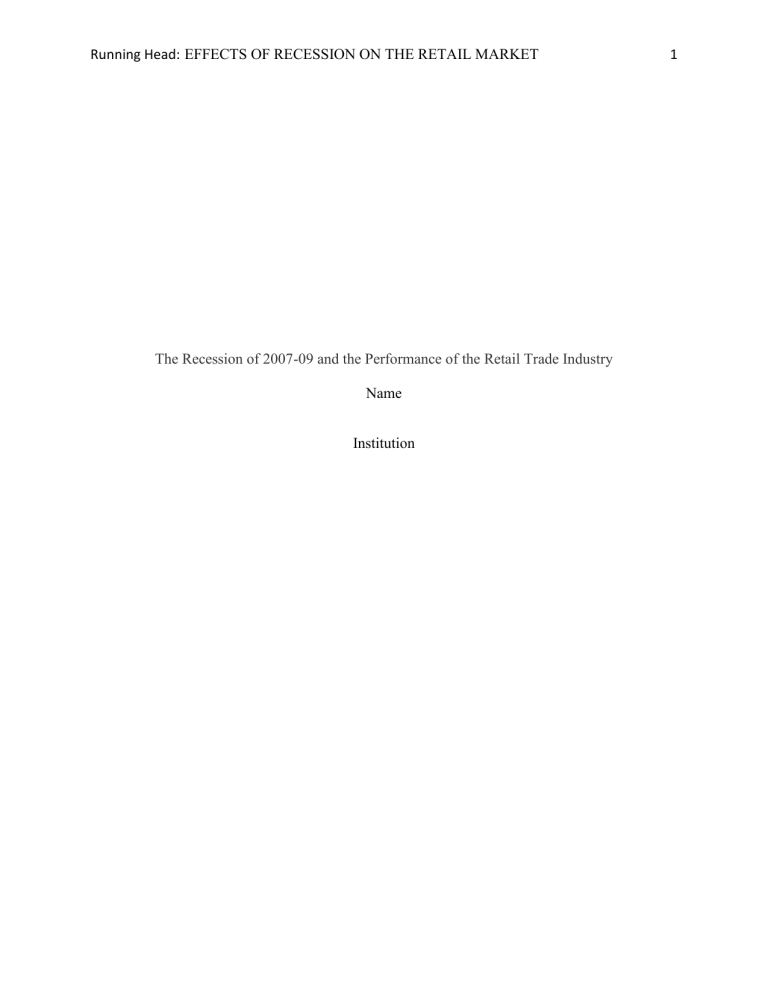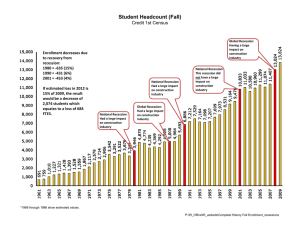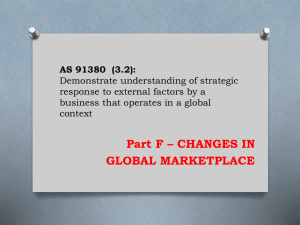
Running Head: EFFECTS OF RECESSION ON THE RETAIL MARKET The Recession of 2007-09 and the Performance of the Retail Trade Industry Name Institution 1 EFFECTS OF RECESSION ON THE RETAIL MARKET The Great recession took place between December 2007 and June 2009. The recession was the longest recession since World War II and affected all sectors of the economy including the retail industry. The effects of the recession were gross. The Real Gross domestic product (GDP) fell by 4.3 percent within the period, which represented the highest decline since the World War II (Alegre & Pou, 2016). The recession also affected unemployment rate which was recorded at 5 percent in December 2007 and increased to 9.5 percent by June 2009. By the end of October, the unemployment rate had reached 10 percent. The recession had numerous microeconomic effects. Due to increased inflation and unemployment, the income levels fell drastically adversely affecting the income distribution. The recession thereby led to reduced spending especially for non-durables. By the fourteenth quarter since the recession started, spending was at least 5 percent lower that the levels registered at the beginning of recession (Colburn & Allen, 2018). The reduced spending was also evident in household items. Although policies like the reduction of VAT were implemented to support household spending, the effects of the recession continued to be felt across industries. One of the sectors of the economy that were worst affected by the recession was the retail sector. The retail sector is linked directly to factors like household consumption, level of unemployment, income level and food prices among others that experienced changes during the recession (Hollander & Liu, 2016). The retail sector therefore becomes a vital industry to evaluate policies implemented to reduce the effects of the recession, their impact and proposed future strategies to reduce the impact of adverse economic situations. Cause of the Great Recession The financial recession was mainly caused by the contraction of the liquidity in the financial markets. The main cause of the recession was the bursting of the U.S. housing bubble. 2 EFFECTS OF RECESSION ON THE RETAIL MARKET Starting from 2001, the banks reduced the “prime” interest rates which are interest rates charged on low-risk customers (Hollander & Liu, 2016). The reduction enabled banks and other financial institutions to issue low interest rates to an increased number of customers. However, by 2005, the demand for housing declined thereby decreasing the home prices (Kaltwasser & Zanotti, 2018). Majority of the subprime customers who held adjustable-rate mortgages (ARMs) were unable to pay their loans collapsing the mortgage market. The US Retail Industry The retail industry in the United States is the largest in the world. The industry is 50 percent larger than that of China even though China has a population of over one billion. The retail market is an oligopoly market whereby a small number of companies control a considerable proportion of the market. The 12 largest retail companies hold over 40 percent of the total market share (Timmer & Inklaar, 2015). The supply and demand of commodities in the retail industry were affected by the recession. The retail stores sell numerous products and services which can either be categorized as giffen, normal or inferior goods. For the normal goods, the demand for such goods decreased. The recession reduced the purchasing power of the customers and thus the purchased lesser number of goods in an attempt to spend less. Thus, the demand curve for the normal goods during the recession shifted to the left (Hortaçsu & Syverson, 2015). The inferior goods were also affected by the recession. For the inferior goods, the demand for the goods increased as the consumers substituted normal goods for cheaper inferior goods. The demand curve for the inferior goods therefore shifted to the right during the recession (Hortaçsu & Syverson, 2015). The supply of the goods was also adversely affected during the recession. The supply for most products increased more than the demand for the 3 EFFECTS OF RECESSION ON THE RETAIL MARKET goods. Since more people could not afford the normal goods, the availability of the goods increased drastically. Overstocking was a common experience in the retail stores. Literature review To understand the effects of the recession on the retail industry, it is prudent to first understand the market structure of the U.S. retail industry. Evans and Mathur (2014) carried out a study to investigate the retailing industry in the United States for the period leading to the Great Recession. The study carried out a 25-year financial ratio analysis of the US to evaluate whether the retailing industry experienced a decline due to the recession or was already experiencing challenges before the recession. The research acknowledged that there was limited research on the totaling US retailing over time. Data for the study was collected from US retailers from 54 different sectors between 1982 and 2007 (Evans & Mathur, 2014). The researchers utilized the Dun & Bradstreet's annual Industry Norms & Key Business Ratios to analyze the data. The study showed that most financial tools including current ratio, liability to net worth, return on assets and financial leverage portrayed a declining retail sector before the recession. However, the researchers acknowledged that the recession further complicated the already ailing sector. The researchers proposed that retailers should analyze the key solvency (liquidity) factors and efficiency financial ratio measures to ensure sustainability during a recession. Retailing strategies during an economic recession There are numerous strategies that can be implemented by retailers to sustain their operations during an economic recession. Sands and Ferraro (2010) carried out a study to investigate the strategies that were implemented by various retailers during economic turmoil across the world. The purpose of the research was to investigate how retailers respond to 4 EFFECTS OF RECESSION ON THE RETAIL MARKET economic downturn and compare the strategies across different geographical locations, sectors of operation and size of the firms. Data for the study was obtained from 50retail managers selected from various countries including the United States, New Zealand and Australia (Sands & Ferraro, 2010). The method of data collection utilized in the study was face-to-face interviews. The managers were obtained from different retail categories. Additionally, the study utilized secondary sources of data including journal articles and online reports. The study showed that although recessions and other financial turndowns adversely affect the retail industry, the changes also present growth opportunities for the retailers. Retailers can survive during recessions if they implement effective business practices. Among the most effective strategies that wer found to be effective during the economic turndowns include personalized offerings, differentiation of products, and realignments that change consumer values. Also, retailers reduced costs of particular gods and investments to increase turnover and reduce capital expenditure. The major limitation of the study was the generalizability of the findings. The researchers acknowledged that different strategies worked better for large sized companies located in particular geographical locations. Changes in Consumer Behavior during Recession The strategies implemented by retailers during recessions are mainly created to respond effectively to changes in consumer behavior. Velia and Filip (2011) carried out a research to investigate how consumer behavior changed due to economic crisis including economic recession. To determine changes in consumer behavior, the study outlines the main features of the “new” consumer created after the recession. Data for the study was obtained from secondary materials published by researchers from different countries to access customers’ behavior in times of economic crisis. The study critically analyzed the material in an effort to create an 5 EFFECTS OF RECESSION ON THE RETAIL MARKET image of the “new” customer in the retail industry. According to the results, the customers became more economical-cautious. Before the recession, consumers were less concerned with the prices of commodities and changes in the prices over time (Voinea & Filip, 2011). However, after the recession, the customers started making drastic decisions depending on the commodity prices. For example, a change in the price of a commodity led to either a drastic increase or decrease in demand of the commodity in the short-run. Additionally, recessions created ethical consumers, green consumers, smart consumers, and consumers that accept simple offers but with a high utility. The study advised that retailers should first understand the new customers created by the recessionary periods before implementing strategies to respond to the customers’ needs and preferences. Data analysis To understand the economic effect of the great recession on the retail market, it is crucial to evaluate sales before, during and after the recession. Additionally, to compare the impact of the recession with other economic crises, the sales during the great recession should be compared to the retail sales during the “Internet Bubble.” The internet bubble is an economic crisis that occurred between 2001 and 2002. The cause of the bubble was the rapid growth of the technology-dominated Nasdaq index. The index rose from 1,000 in 1995 to over 5,000 in 2000. The graph below shows the monthly retail sales between 1990 and 2011. 6 EFFECTS OF RECESSION ON THE RETAIL MARKET Source: https://www.businessinsider.com/retail-sales-real-consumers-and-theirrecession-level-spending-2011-10?IR=T As evidence in the graph, the recession caused a drastic decrease in retail sales during the great recession. Additionally, the great recession caused a significantly higher decline in sales than the internet bubble. Strategies that Retailers should implement during a recession Create more emotional rather than transactional programs During the great recession, most retailers implemented strategies and policies that would create a more favorable financial environment for their customers (Rapp, Baker, & Bachrach, 2015). For example, most retailers reduced the prices of goods and offered discounts. The financial changes were ineffective as most retailers were forced to close business regardless of 7 EFFECTS OF RECESSION ON THE RETAIL MARKET the strategies. Thus, the retailers should focus more of creating emotional connections with the customer. Such strategies include increasing home deliveries, introducing limited-edition products and issue resolutions to the customers (Verhoef, Kannan, & Inman, 2015). The retailers should also embrace relational marketing whereby the retailers form a close bond with the customers thereby ensuring customer retention. Supply chain as a differentiating strategy Recession introduces stiff competition in the retail market and retailers are in constant quest to offer differentiated products or services thereby gaining a competitive advantage. Since price differentiation is the most popular factor, a retailer reducing the price of the commodities may not gain the expected incremental profit. Thus, retailers should strive to enhance the supply chain department. As evidenced by most researchers, recession push retailers to reduce their costs. Therefore, transforming the supply chain not only creates a competitive advantage for the retailers but also aids in the reduction of overall costs. For example, retailers can adopt automatic smart packaging thereby attracting more customers and gaining long-term competitive advantage. Additionally, automated smart packaging would reduce labor costs as a reduced number of staff would be necessary to carry out packaging processes. In store brands During the recession periods, consumers are constantly looking for cheaper items due to the reduction in their purchasing power. Instead of viewing the behavior as an adverse effect, retailers can capitalize on the behavior by increasing in-store branding. In-store branding refers to advertisement placed inside the stores to provide more information to the customers (DellaVigna & Gentzkow, 2019). The retailers should create in-store brands that inform customers concerning the commodities with lower prices (Namada, 2018). For example, the 8 EFFECTS OF RECESSION ON THE RETAIL MARKET store can place adverts in the detergents portion of the store that informs the customers concerning the cheaper but quality detergents available. Through the in-store brands, the retailers can attract more customers and create more profits through encouraging bulk purchasing as opposed to higher profit margins. Online marketing During the great recession, online marketing had not emerged as a crucial marketing segment. However, the changes in technology since then have made online marketing a vital area that retailers should critically consider. Online marketing has numerous benefits over the traditional forms of marketing. First, online marketing allow retailers to market their products beyond the borders of the country of origin. (Cavallo, 2017). Thus, online marketing would create international marketing op[opportunities for the retailers especially where only the country of origin has been hit by an economic crisis. Additionally, online marketing would provide an opportunity for retailers to reduce overall costs as it reduces costs related to stocking of the stores. Online marketing also creates an opportunity for retails to advertise their products especially through social media. Shopintainment According to Cao and Li (2015), customers spend money when and where they feel good. Thus, retail customers are expected to spend more time in the stores and purchase more if they are given a good shopping experience. During the recession periods, the demand for various products and services decrease significantly and thus retailers have to develop innovative strategies to attract more customers. Shopintainment presents a perfect opportunity for retailers to attract more customers and increase time taken during shopping. The concept of shopintainment revolves around creating a suitable environment for customers to shop for their 9 EFFECTS OF RECESSION ON THE RETAIL MARKET preferred goods. in the retail stores shopintainment may involve installing computer games where children can play hence allow their parents to shop, decollating the stores and placing comfortable transportation systems which can move customers around the stores. Conclusion Retail industry is among the most profitable industries especially in the United States. However, the industry is subject to prevailing economic factors including adverse economic crisis like recession. During the recession periods, the retail industry experiences a drastic decrease in demand and increased competition. To overcome the adverse effects of recession periods, the retail industry players have to develop creative strategies and policies to ensure their survival. The great recession caught the industry unawares as evidenced by the ineffective survival stratgeis adopted by various firms. However, the retailers should learn from the mistakes and prepare well for any future recession period. Technology provides a perfect opportunity for retailers to cushion themselves from recession periods. Additionally, creative strategies like shopintainment and in-store branding would create a crucial differentiation opportunity for the firms as opposed to decreasing the prices of the commodities. 10




